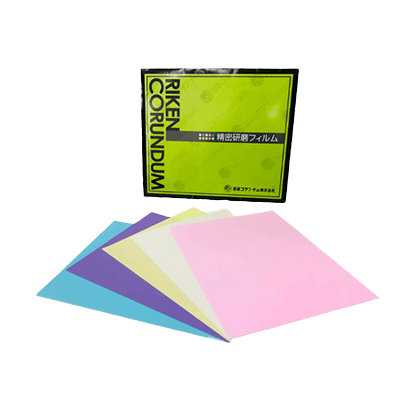What Is a Polishing Film?

A polishing film a type of polishing product used in fine polishing operations.
It is characterized by its high abrasiveness and ability to produce a high-quality finish. As a result, it can be polished more finely than abrasive cloth or abrasive paper.
Uses of Polishing Films
Polishing films are used for automatic polishing, precision polishing, and finishing operations, taking advantage of the water resistance and strength of the film material.
Suitable materials include glass, plastics, resins, and other materials that require a high level of finish. A specific example is the polishing of medical equipment made from these materials.
Principles of Polishing Films
1. Structure of Polishing Films
Polishing films are made of a strong resin film such as polyester or polyethylene, to which abrasive particles are applied.
In addition, the use of high-strength resin polishing films provides high resistance to tension, tearing, etc., and can be used for automatic polishing using a machine.
2. Polishing Films Manufacturing Method
Polishing films can be manufactured by either applying the abrasive to the resin film with a roller or by using static electricity to adhere the abrasive to the film.
Method of Applying Polishing Films with Rollers
In the first process, a strong resin such as polyester or polyethylene is stretched so that it is flat and smooth in thickness to form a film. The next step is to apply and knead the fine particles of the abrasive evenly on the film using a roller. The result is an abrasive film in which the surface of the film is coated with abrasive particles.
Method of Adhering Abrasive Using Static Electricity
First, an adhesive is applied to the surface of a strong resin film such as polyester or polyethylene. The next step is to use static electricity to adhere abrasive particles to the adhesive. The final step is to re-coat the adhesive to prevent the abrasive particles from falling off. The result is Polishing Films with the abrasive sandwiched and secured by the adhesive on the film.
Comparing polishing films produced by the two methods, polishing films that use static electricity to apply the abrasive have higher polishing power. This is because when the abrasive is applied electrostatically, the particles of the abrasive align themselves in the same direction, exposing more of the abrasive that contributes to polishing.
Other Information on Polishing Films
1. Polishing Films Grain Size
Polishing film specifications are marked #2000, etc. The “#xx” indicates the particle size of the abrasive particles in polishing films. For example, #2000 is generally used for rough finishing, and #15000 for a more mirror-like surface.
For particle sizes above #400, the ratio of particle size to particle diameter may not be clearly defined as a specification, so care should be taken when using these products. The standard conversion ratio is 15000/particle size = particle size, so it is possible to get a rough idea from the particle size or particle diameter.
However, since the notation may differ from manufacturer to manufacturer, it should be taken as a reference value only, and inquiries should be made to the distributor for details. In addition, polishing films with a grain size of #15000, which is as high as diamond paste, are also available these days, expanding the use of Polishing Films.
2. The Back and Front of Polishing Films
If you are using polishing films for the first time, you may not know which side of the polishing films is the reverse side or the polishing side. Abrasive films have a glossy side and a non-glossy side, and the abraded side is the non-glossy side.
This is because the polishing films surface is rougher than the other side of the film, which is the non-glossy side. Especially with #15000, which has a larger particle size, the abrasive particles are finer and the coated surface is also glossy, so use with more care.